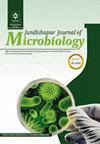抗抗生素铜绿假单胞菌中抗菌编码基因的高患病率和表型抗菌易感性的降低
IF 0.5
4区 医学
Q4 MICROBIOLOGY
引用次数: 0
摘要
背景:铜绿假单胞菌的多重耐药(MDR)和广泛耐药(XDR)是临床关注的问题。目的:为确定耐药基因的分布及其对季铵盐和双胍类化合物的表型耐药水平,对同一医院不同感染患者中收集的耐多药和耐广药铜绿假单胞菌进行了研究。方法:对2020年分离的铜绿假单胞菌进行对苯并氯铵(BTC)、苯并氯铵(BKC)和二光酸氯己定(CHG)的体外药敏试验。用肉汤微量稀释法测定了对这些抗菌剂的最低抑菌浓度。同时,采用聚合酶链反应(PCR)介导的qacE、qacEΔ1和blaOXA-23基因检测。结果:根据其表型和基因型的非相似性,分离物大部分是非克隆的(检测到35个总体数据组合类型)。大多数铜绿假单胞菌感染发生在重症监护病房(ICU)患者(n = 43, 61.4%)。广泛耐药表型和耐多药表型分别占20%和12.6%。在留存的70株分离菌中,53株(75.7%)携带至少一种耐药基因,其中11株(20.7%)只携带qacEΔ1基因;7株(13.2%)含有qacE基因。35株(66%)分离株同时检测到qacE和qacEΔ1基因。BTC (24.0 vs 10.56µg/mL)、BKC (46.1 vs 17.22µg/mL)和CHG (107.7 vs 29.4µg/mL)的平均mic在携带抗菌耐药基因的分离株中显著高于其他未携带此类基因的分离株。结论:耐药铜绿假单胞菌对抗菌药物的mic显著升高,强调了监测这种增高和实施有效感染控制的重要性。本文章由计算机程序翻译,如有差异,请以英文原文为准。
High Prevalence of Antiseptic Resistance Encoding Genes and Reduced Phenotypic Antiseptic Susceptibility Among Antibiotic-Resistant Pseudomonas aeruginosa Isolates
Background: Multi-drug resistant (MDR) and extensively drug-resistant (XDR) Pseudomonas aeruginosa isolates are of clinical concern. Objectives: To determine the distribution of antiseptic resistance genes and the associated level of phenotypic antiseptic resistance against quaternary ammonium compounds and biguanide compounds, we studied MDR and XDR P. aeruginosa isolates collected from different infections among patients from a single hospital. Methods: Pseudomonas aeruginosa isolates were investigated in 2020 for in vitro susceptibility to benzethonium chloride (BTC), benzalkonium chloride (BKC), and chlorhexidine digluconate (CHG). The minimum inhibitory concentrations (MICs) against these antiseptic agents were determined using broth microdilution. Also, polymerase chain reaction (PCR)-mediated detection of qacE, qacEΔ1, and blaOXA-23 genes was used. Results: Isolates were largely non-clonal according to their phenotypical and genotypical non-similarity (35 overall data-combination types detected). Most P. aeruginosa infections occurred in intensive care unit (ICU) patients (n = 43, 61.4%). Extensively drug-resistant and MDR phenotypes were detected in 20% and 12.6%, respectively. Among the 70 isolates retained, 53 (75.7%) harbored at least one resistance gene, comprising 11 (20.7%) isolates with solely the qacEΔ1 gene; seven (13.2%) isolates harbored the qacE gene. Both the qacE and qacEΔ1 genes were detected simultaneously in 35 (66%) isolates. The mean MICs for BTC (24.0 versus 10.56 µg/mL), BKC (46.1 versus 17.22 µg/mL), and CHG (107.7 versus 29.4 µg/mL) were statistically significantly higher among antiseptic resistance gene harboring isolates than in other isolates without such genes. Conclusions: The significantly increased MICs against antiseptic agents among antibiotic-resistant P. aeruginosa isolates highlight the importance of monitoring such increases and implementing effective infection control.
求助全文
通过发布文献求助,成功后即可免费获取论文全文。
去求助
来源期刊

Jundishapur Journal of Microbiology
MICROBIOLOGY-
CiteScore
1.30
自引率
0.00%
发文量
56
审稿时长
6-12 weeks
期刊介绍:
Jundishapur Journal of Microbiology, (JJM) is the official scientific Monthly publication of Ahvaz Jundishapur University of Medical Sciences. JJM is dedicated to the publication of manuscripts on topics concerning all aspects of microbiology. The topics include medical, veterinary and environmental microbiology, molecular investigations and infectious diseases. Aspects of immunology and epidemiology of infectious diseases are also considered.
 求助内容:
求助内容: 应助结果提醒方式:
应助结果提醒方式:


